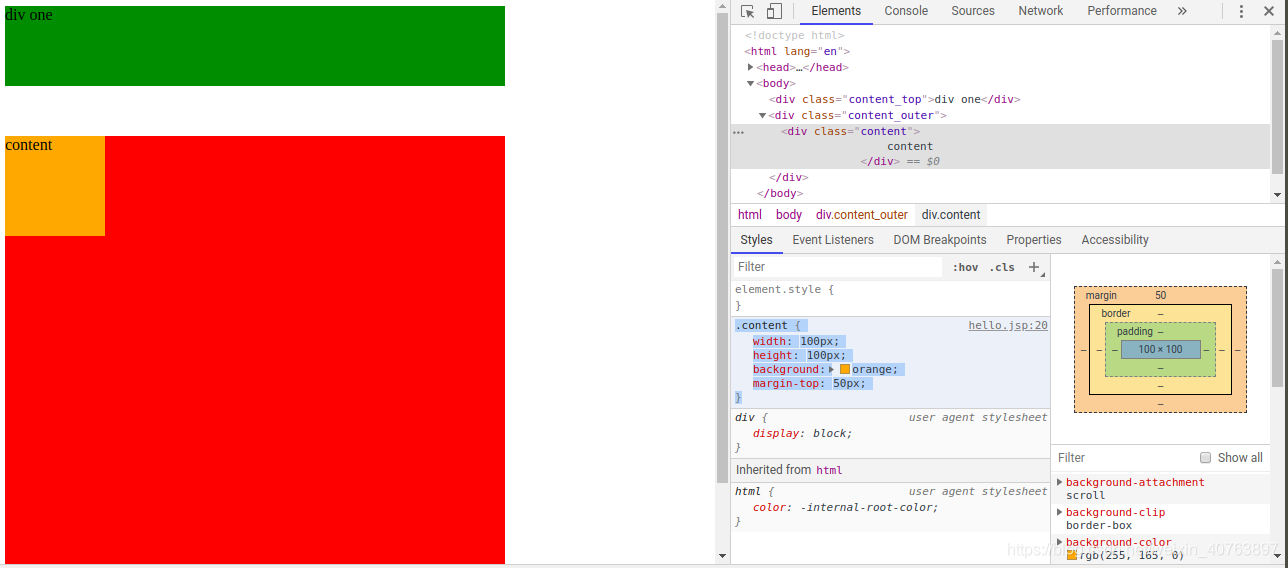css中子元素设置margin-top会影响到父元素
demo代码:
<!DOCTYPE html>
<html lang="en">
<head> <meta charset="UTF-8"> <title>index</title> <style> .content_top{ width: 500px; height: 80px; background-color: green; } .content_outer{ width: 500px; height: 500px; background-color: red; } .content { width: 100px; height: 100px; background: orange; } </style>
</head>
<body> <div class="content_top">div one</div> <div class="content_outer"> <div class="content"> content </div> </div>
</body>
</html>
- 1
- 2
- 3
- 4
- 5
- 6
- 7
- 8
- 9
- 10
- 11
- 12
- 13
- 14
- 15
- 16
- 17
- 18
- 19
- 20
- 21
- 22
- 23
- 24
- 25
- 26
- 27
- 28
- 29
- 30
- 31
- 32
- 33
- 34
- 35
效果

出现问题的地方:
修改content div的margin-top:
.content { width: 100px; height: 100px; background: orange; margin-top: 50px;
}
- 1
- 2
- 3
- 4
- 5
- 6
效果

很奇怪,只是修改了content div顶外边距,为什么会影响到父div呢?
CSS的技术文档中有这么一段话:、
In this specification,the expression collasing margins means that adjoining margins(no non-empty content,padding or border areas or clearance separate them)of two or more boxes(which may be next to on another or nested)combine to form a single margin。
大意为折叠边距意味着会邻接两个或多个盒元素的没有非空内容、没有内边距、没有边区域或用间隙分开它们的外边距合并成一个外边距。
以上就是产生这种现象有原因。父元素的第一个子元素的上边距margin-top如果碰不到有效的border或者padding或者非空内容(如一段文字),就会一层一层地合并父元素的margin-top成一个单独的margin-top。因此只要给父元素设置个有效的 border或者padding或在子元素前增加一段非空内容(如文字)就可以阻止它去合并父元素的外边距啦。
解决办法:
1、在子元素添加非空内容
<html lang="en">
<head> <meta charset="UTF-8"> <title>index</title> <style> .content_top{ width: 500px; height: 80px; background-color: green; } .content_outer{ width: 500px; height: 500px; background-color: red; } .content { width: 100px; height: 100px; background: orange; margin-top: 50px; } </style>
</head>
<body> <div class="content_top">div one</div> <div class="content_outer"> <div>Hello World</div> <div class="content"> content </div> </div>
</body>
</html>
- 1
- 2
- 3
- 4
- 5
- 6
- 7
- 8
- 9
- 10
- 11
- 12
- 13
- 14
- 15
- 16
- 17
- 18
- 19
- 20
- 21
- 22
- 23
- 24
- 25
- 26
- 27
- 28
- 29
- 30
- 31
- 32
- 33
- 34

2、父元素增加padding
<html lang="en">
<head> <meta charset="UTF-8"> <title>index</title> <style> .content_top{ width: 500px; height: 80px; background-color: green; } .content_outer{ width: 500px; height: 500px; background-color: red; padding-top:20px; } .content { width: 100px; height: 100px; background: orange; margin-top:50px; } </style>
</head>
<body> <div class="content_top">div one</div> <div class="content_outer"> <div class="content"> content </div> </div>
</body>
</html>
- 1
- 2
- 3
- 4
- 5
- 6
- 7
- 8
- 9
- 10
- 11
- 12
- 13
- 14
- 15
- 16
- 17
- 18
- 19
- 20
- 21
- 22
- 23
- 24
- 25
- 26
- 27
- 28
- 29
- 30
- 31
- 32
- 33
3、给父元素添加边区域
<html lang="en">
<head> <meta charset="UTF-8"> <title>index</title> <style> .content_top{ width: 500px; height: 80px; background-color: green; } .content_outer{ width: 500px; height: 500px; background-color: red; border-top: red solid; } .content { width: 100px; height: 100px; background: orange; margin-top: 50px; } </style>
</head>
<body> <div class="content_top">div one</div> <div class="content_outer"> <div class="content"> content </div> </div>
</body>
</html>
- 1
- 2
- 3
- 4
- 5
- 6
- 7
- 8
- 9
- 10
- 11
- 12
- 13
- 14
- 15
- 16
- 17
- 18
- 19
- 20
- 21
- 22
- 23
- 24
- 25
- 26
- 27
- 28
- 29
- 30
- 31
- 32
- 33
- 34

4、给父元素设置overflow:hidden,auto、scroll、overlay都可以
.content_outer{ width: 500px; height: 500px; background-color: red; overflow:auto; }
- 1
- 2
- 3
- 4
- 5
- 6
5、父元素或者子元素使用浮动或者绝对定位。
谢谢阅读!
文章来源: blog.csdn.net,作者:WongKyunban,版权归原作者所有,如需转载,请联系作者。
原文链接:blog.csdn.net/weixin_40763897/article/details/103020863
- 点赞
- 收藏
- 关注作者


评论(0)